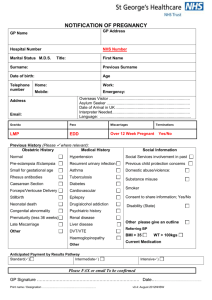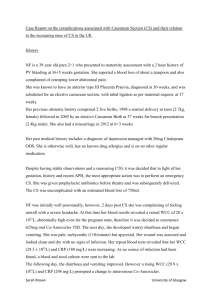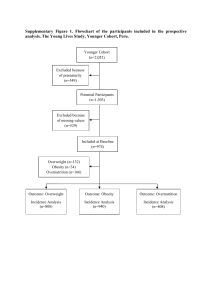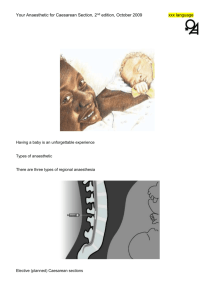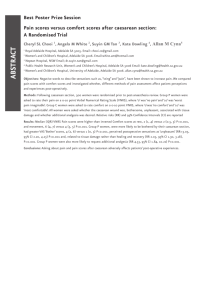Caesarean section delivery in India
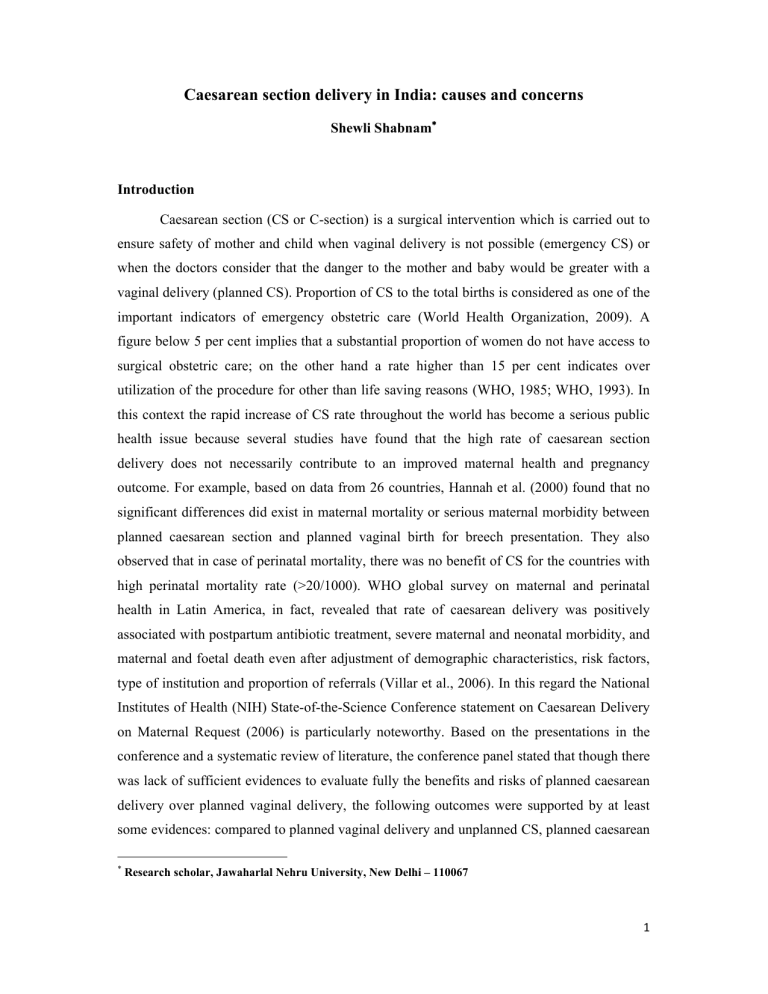
Caesarean section delivery in India: causes and concerns
Shewli Shabnam
Introduction
Caesarean section (CS or C-section) is a surgical intervention which is carried out to ensure safety of mother and child when vaginal delivery is not possible (emergency CS) or when the doctors consider that the danger to the mother and baby would be greater with a vaginal delivery (planned CS). Proportion of CS to the total births is considered as one of the important indicators of emergency obstetric care (World Health Organization, 2009). A figure below 5 per cent implies that a substantial proportion of women do not have access to surgical obstetric care; on the other hand a rate higher than 15 per cent indicates over utilization of the procedure for other than life saving reasons (WHO, 1985; WHO, 1993). In this context the rapid increase of CS rate throughout the world has become a serious public health issue because several studies have found that the high rate of caesarean section delivery does not necessarily contribute to an improved maternal health and pregnancy outcome. For example, based on data from 26 countries, Hannah et al. (2000) found that no significant differences did exist in maternal mortality or serious maternal morbidity between planned caesarean section and planned vaginal birth for breech presentation. They also observed that in case of perinatal mortality, there was no benefit of CS for the countries with high perinatal mortality rate (>20/1000). WHO global survey on maternal and perinatal health in Latin America, in fact, revealed that rate of caesarean delivery was positively associated with postpartum antibiotic treatment, severe maternal and neonatal morbidity, and maternal and foetal death even after adjustment of demographic characteristics, risk factors, type of institution and proportion of referrals (Villar et al., 2006). In this regard the National
Institutes of Health (NIH) State-of-the-Science Conference statement on Caesarean Delivery on Maternal Request (2006) is particularly noteworthy. Based on the presentations in the conference and a systematic review of literature, the conference panel stated that though there was lack of sufficient evidences to evaluate fully the benefits and risks of planned caesarean delivery over planned vaginal delivery, the following outcomes were supported by at least some evidences: compared to planned vaginal delivery and unplanned CS, planned caesarean
Research scholar, Jawaharlal Nehru University, New Delhi – 110067
1
delivery was associated with (1) a lesser risk of postpartum haemorrhage and stress urinary incontinence, (2) an increased risk of infection, anaesthetic complications and placenta previa, (3) greater complications in subsequent pregnancies, (4) longer hospital stay of mothers and neonates, (5) higher risk of respiratory morbidity for infants and (6) a lower rate of foetal mortality, birth injury, neonatal asphyxia and encephalopathy. The above findings are also supported by some recent studies done by Tollanes (2009), Guise et al. (2010) and
Ecker J. (2013). Besides, unnecessary caesareans generate higher expenditure at individual and national levels and have the potential to divert human and financial resources from higher priority intervention (Lauer et al., 2010). In 2008, the cost of the global excess/unnecessary
C-section delivery was estimated approximately 2.32 billion US dollar (Gibbons et al., 2010).
In spite of these facts, CS is high and continues to rise in the developed world and in many developing countries.
Betran and her colleagues (2007) estimated that at the beginning of twenty first century the average CS rate was 3.5 per cent in Africa, 14.9 per cent in Oceania and in all other continents, it was above the 15 per cent mark (15.9 per cent in Asia, 19 per cent in
Europe, 24.3 per cent in North America and 29.2 per cent Latin America and the Caribbean).
However, they observed striking variations in the rate of CS among the countries of the same continent. In the United States of America, the proportion of caesarean birth to total births increased from 20.7 per cent in 1996 to 31.1 per cent in 2006 (MacDorman et al., 2008). In
Brazil, C-section delivery rate has jumped from 15 per cent in 1974 to 45.9 per cent in 2008
(Chacham and Perpetuo, 1998, Gibbons et al., 2010). Many of the developing countries (e.g.,
China, Nigeria, Bangladesh etc.) have seen rapid increase in caesarean section birth in the past two decades (Ibekwe, 2004; Sufang et al., 2007; Leone et al., 2008).
The increasing trend of CS has generated much controversy regarding the causes of such tendency. In developing nations like China, one important reason of growing rate of CS can be attributed to the increase of institutional births (Sufang et. al., 2007). Among other reasons, demographic profiles of mothers (Chacham and Perpetuo, 1998; Declercq et al.,
2005), fear of litigation among caregivers (Vimercati et al., 2000; Tollanes, 2009), physician’s convenience (Gomes et al., 1999), insurance facility and mode of hospital payment (Remez, 1991; Bertollini et al., 1992) and profit-oriented private health care system
(Chacham and Perpetuo, 1998; Hopkins, 2000; Potter, 2001) are found to be associated to the rise of C-section delivery. Patients’ preference for CS is regarded as a common cause behind increasing elective caesarean delivery rate (MacDorman et al., 2008). However, a number of studies have found that caesarean cases on maternal request are actually rare (Hopkins, 2000;
2
Potter, 2001) and many personal and societal reasons including fear of labour pain and future sexual dissatisfaction, perceived unsympathetic and inadequate care during vaginal delivery underpinned these requests (Mello e Souza, 1994; Oumachigui, 2006; McCourt et al., 2007).
In India the rate of caesarean section delivery has increased from 3 per cent to 10 per cent between 1992-93 and 2005-06 (IIPS, 2007) which is lower compared to some developing nations like Brazil and China. But as India is the second most populous country in the world, a small percentage increase affects a huge number of people. If we follow the 1985 guideline of WHO (as in 2009 WHO stated that ‘optimum rate is unknown’ and world regions might want to continue to use a range of 5-15% or set their own standard), at national level the present rate of CS does not seem to be alarming but at regional level the scenario is quite opposite. Using the data of National Family Health Survey, India, 1992-93, Mishra and
Ramanathan (2002) found that among 18 large states, two states had CS rate near 15 per cent and the rest had less than 5 per cent. The works of Biswas et al. (2005) established that the basic emergency obstetric care (EmOC) were inadequate and causing maternal death in many parts of India. On the other hand, data from a large teaching hospital of Kolkata shows that between 1990 and 1995, of all deliveries, caesarean deliveries were carried out in 50 per cent cases (Pahari and Ghosh, 1997). Kambo et al. (2002) analyzing the data of 30 medical colleges found that the rate of CS increased from 21.8 percent in 1993-94 to 25.4 per cent in
1998-99. Another study by Sreevidya and Sathiyasekaran (2003) revealed that in Madras city
(Chennai), between June 1997 and May 1999, the CS rate was 32.6 per cent. They also found that private sector deliveries had a higher odds ratio of a primary C-section delivery in comparison with public sector after covariate adjustment. Similar findings are indicated in several other studies (Padamdas et al., 2000; Mishra and Ramanathan, 2002).
Objectives
Keeping in view the above background, present study seeks to examine the level and trend of the caesarean section delivery in India and its states. It also tries to indentify various factors associated with caesarean delivery in Indian context. Another objective of this study is to understand the possible reasons of very high rate CS in some parts of India.
Data base and methodology
The dataset of District Level Household and Facility Survey (DLHS-3), 2007-08 has been analyzed for the purpose of this study. The analysis is based on information regarding the latest birth of ever-married women aged 15-49, who had given birth (both live and still birth) since January 1, 2004 and reported the type of delivery. To understand the trend of the rates of C-section delivery, along with DLHS-3, data from 1 st
, 2 nd and 3 rd round of National
3
Family Health Survey (NFHS) has been used. A logistic regression model has been used to identify the net impact of demographic, socio-economic and institutional factors on woman’s experience of caesarean section delivery. To understand the possible reasons of very high CS rate, informal conversation was carried out with some doctors and patients from different government and private hospitals.
Results
Level of caesarean section delivery in India
Based on DLHS-3 data, the caesarean section delivery rate in India is 9.2 per cent.
However, a substantial inter-state variation of CS exists in India (Table 1). Among the large states (population 10 million and above as per 2001 census), the proportion of women who have undergone caesarean deliveries is the highest in Kerala (31.8 per cent) followed by
Andhra Pradesh (29.3 per cent) and Tamil Nadu (23.2 per cent) and the lowest in Rajasthan and Jharkhand (4.2 per cent in both the states). Fig 1 shows a distinct regional pattern in the distribution of C-section birth in India. Except Karnataka, in all other southern states, Csection delivery has crossed the WHO recommended level of 15 per cent. Among major states, CS rate of 5 percent or lower prevails in Bihar, Jharkhand, Uttar Pradesh, Madhya
Pradesh and Rajasthan. During 2007-09, the maternal mortality ratio (MMR)
1 and in 2008 the infant mortality rate (IMR)
2 in these states were also very high (Registrar General, India,
2009 and Office of Registrar General, India, 2011). So, it can be argued that these states suffer from lack of health facilities to meet surgical obstetric needs which partly explain higher mortality and ill health of mothers and their babies in these states.
In India the rural-urban difference between C-section rates is quite conspicuous. The rate of CS is higher in urban areas than their rural counterparts for all the states (Table 1).
The rural-urban gap is relatively low in the states of Haryana, Delhi, Arunachal Pradesh and
Kerala (below 5 percentage points). On the other hand, the gap is very high in the states of
Jammu & Kashmir, West Bengal and Tripura (above 20 percentage points). The higher urban rates may be a reflection of combination of factors like higher availability and utilization of maternal health care services, larger concentration of private health institutions in the cities and towns etc. Moreover, the demographic and socio-economic backgrounds of the persons living in the rural and urban places affect the CS rate to a great extent. Here it should be
1
MMR measures the number of women aged 15-49 years dying due to maternal causes per 1,00,000 live births.
MMR of Rajasthan, Bihar/Jharkhand, Uttar Pradesh and Madhya Pradesh during 2007-09 was 318, 261, 359and
269 respectively while the national average was 212
.
2
IMR (number of child died before age one per 1000 live births) in Rajasthan, Bihar, Jharkhand, Uttar Pradesh and Madhya Pradesh in 2008 was 63, 56, 46, 67 and 70 respectively while the national average was 36
.
4
mentioned that among large states, Jammu and Kashmir, West Bengal, Andhra Pradesh,
Kerala and Tamil Nadu report alarmingly high (above or close to 30 percent) CS rate in urban areas. In Andhra Pradesh, Kerala and Tamil Nadu, even in rural areas, caesarean delivery rates are much higher than WHO recommended standard of 15 percent.
Trend in CS and institutional delivery in India
The trend in institutional delivery and CS is shown in table 2. It shows that Jammu &
Kashmir, Punjab, Haryana, Rajasthan, Orissa, Madhya Pradesh, Andhra Pradesh, and Tamil
Nadu have experienced considerable increase in institutional delivery between 1992-93 and
2007-08. Except Rajasthan and Madhya Pradesh, all these states also show the evidence of significant rise in caesarean section births during these 15 years. Andhra Pradesh requires special mention for the highest increase of institutional delivery and caesarean births in the aforesaid period. In fact, the present analysis indicates that the rate of caesarean delivery is more in the states where institutional delivery is also high. Institutional delivery assures better maternal and child health care. In the institutional set up if complications arise during pregnancy or delivery time, the physicians resort to caesarean sections to save the lives of mother and child. Therefore, usually there is a positive correlation between institutional delivery and rate of CS.
However it should be mentioned here that the sampling techniques used in DLHS and
NFHS are different. Therefore, some variations are found in the results of DLHS-3 and
NHFS-3 though in most of the cases the variations are not large.
Role of Private sector
In India the rate of CS is substantially higher in private health care institutions compared to public health care institutions. There are six states where the caesarean section delivery rate between the private and public medical institutions is above 20 percentage points. In West Bengal and Andhra Pradesh one in every two mothers experience CS in the private health care institutions. The rate is even higher than Turkey and Brazil and a matter of serious concern. These findings indicate the incidence of unnecessary medical intervention during delivery in private medical institutions. As caesarean delivery remains profitable for both the doctor and the institution, CS is always higher in private medical centres. However, there are several states where caesarean delivery in government institutions is nearly or above
15 per cent (Table 3). In Kerala, though the difference in CS rate is 6.4 percent points between private and public medical institutions, the rate in public institutions is as high as
27.8 percent. Therefore, private institutions alone should not be blamed for the increasing rate of CS.
5
Factors associated with caesarean delivery in India – results from bivariate and multivariate analysis
A combination of demographic, socio-economic and institutional factors determines the rate of caesarean section delivery in any region. As the process of surgical intervention is possible only in a proper medical set up, therefore it is obvious to have caesarean delivery in an institute. Here I will discuss various factors associated with CS under institutional set up.
The bivariate analysis (Table 4) reveals that caesarean delivery is highest among mothers of age group above 34 years. CS rate is higher for women having multiple births and having baby for the first time. Also the percentage of women who have undergone C-section delivery is higher among those who sought treatment for pregnancy complication or suffered from delivery-related complications. There is a steady rise in percentage of women experiencing caesarean delivery with increasing wealth index and years of schooling of mothers. Higher percentage of CS is observed among non SC/ST (SC-Scheduled Caste, ST-
Scheduled Tribe) women than the SC/ST group. Further, the percentage of women who have caesarean delivery is higher among those who are under any insurance coverage/health scheme and living in urban areas. It is found that while only 11.9 per cent of women have undergone CS in public medical institution, the figure is more than double (28 per cent) in case of private health care institution. In India distinct regional variation is found in caesarean delivery rates. In west and north-east India around 13 per cent women experience CS while in south India 28.2 per cent women have caesarean deliveries.
To examine the net effect of the explanatory variables on women’s experience of caesarean section delivery (dependent variable), a logistic regression model has been used
(Table 5). Here the dependent variable is coded as ‘0’ when the woman has not experienced
CS and coded as ‘1’ if the woman has undergone CS. Odds ratio greater than one indicates a positive relationship between the predictor variable and the probability of experiencing CS, and odds ratio less than one indicates a negative relationship.
The logistic regression analysis reveals that caesarean section delivery is significantly associated with maternal age, birth order, multiple births, treatment of pregnancy complications and complications during delivery. Controlling for other factors, caesarean section delivery is more likely to occur among the mothers aged more than 34 years compared to mothers below 20 years. It is because the chances of pregnancy complication are more at higher age. This finding corroborates the findings of Rosenthal and Paterson (1998) and Padmadas et al. (2000). Peipert and Bracken (1993) also points out that both physicians and patients remain concerned about pregnancy outcome at older age. So the doctors opt for
6
CS for older women even if there is no pregnancy complication. Birth order is a significant determinant of CS because primiparity is associated with greater pregnancy complications
(Mishra and Ramanathan, 2002). Multiple births also increase the possibility of undergoing
C-section delivery. Present analysis supports both the facts. Complications during pregnancy are important factors that may raise the chances of planned caesarean delivery. The logistic regression shows that compared to those who did not suffer from pregnancy complications or did not seek for treatment for pregnancy complications, those who sought for treatment are more likely to have caesarean baby. As expected, the chance of CS is higher among those who have experienced delivery complications (excessive bleeding, hypertension, prolonged labour, obstructed labour, breech presentation, convulsion etc.) than those who did not experience any delivery complication.
The present study finds that after covariate adjustment, women who have completed
5-10 years schooling or higher are significantly more likely to experience caesarean delivery than those who never attended school. In fact, education increases women’s decision making power regarding their own health care and it is believed that many highly educated women prefer elective caesarean. The work of Chacham and Perpetuo (1998) and Ghosh and James
(2010) also depict that higher education is associated with greater incidence of CS.
Among social factors religion and caste have small but significant impact on caesarean delivery.
Mothers with high standard of living are usually inclined to utilise health institutions, especially private hospitals (Padamadas et al., 2000). Families with higher socioeconomic status can easily access and afford the cost of CS. The present study also depicts that women from rich families are significantly more likely to undergo C-section than women from poor families. The regression analysis shows that, those who are not under any insurance coverage/health scheme are significantly less likely to have C-section delivery. However, the impact is small. When other factors are controlled for, the rate of caesarean section deliveries is significantly higher in private health institutions compared to the public health institutions.
The profit motivated private health institutions are often blamed for higher rate of CS.
Compared to rural areas, caesarean section delivery is more likely to occur at urban areas. It is because of higher concentration of medical institutions particularly private medical institutions in urban areas which facilitates greater institutional deliveries as well as C-section births. The result of the logistic regression analysis also supports this hypothesis.
Finally, the regional factor has been included in this study considering the combining effects of geographical location, cultural setting and socio-economic characteristics on
7
practice and acceptance of CS. In the present analysis India is divided into six regions, namely, northern, central, eastern, north-eastern, western and southern. After covariate adjustment, compared to the north Indian women, south Indian women are more likely to undergone CS and women from central and west India are less likely to experience caesarean delivery.
Possible reasons for high rate of CS
The informal discussions with some doctors and patients revealed a number of reasons for high incidence of CS. Observations from some hospitals in West Bengal corroborate the findings on trends in CS. The oldest Department of Obstetrics and
Gynaecology in India, the Eden Hospital of Calcutta Medical College, Kolkata has seen rise in CS from 9.5 per cent in 1973 to 40.1 per cent in 2012 (Medical College, Kolkata, 1974 and
2013). Data obtained from Ideal Hospital, a private hospital situated near a sub-divisional hospital in West Bengal (and representative of many such hospitals and nursing homes of urban fringe area) shows excessively high rate of caesarean delivery. In 2006-07 the rate was
55 per cent. Within five years the rate has increased 17 percentage point to become 72 per cent in 2011-12. The manager of a private hospital clearly admitted the nexus between the doctors of sub-divisional hospital and the owners of the surrounding nursing homes/private hospitals. Two patients informed the researcher that the doctor of the government hospital told them they needed CS and proper CS facility was unavailable there; so they must go to
Calcutta Medical College (which was 45 km away) or get admitted at nearby good nursing home chosen by the doctor. According to the manager, the sub-divisional hospital usually remains dirty and the dais and nurses in the hospitals often behave very rudely with the patients, particularly during labour pain. These well-known facts discourage the patients to go to government hospital. It is interesting to note that all the patients whom I met were from lower, lower-middle or middle class background and none of them opted for elective caesarean. The finding is quite similar with the findings from Brazil (Hopkins, 2000; Potter,
2001). These women were quite aware that CS would be painful after birth. Family members of few patients said that as recovery after CS would take longer time than normal delivery they did not want CS because “who will do household chores for a long time?”
Discussions with doctors are also important to understand the high rate of CS in many parts of India. According to the doctors caesarean section is normally justified under certain situations such as dystocia, cephalopelvic disproportion, placenta previa, breech presentation, foetal distress, multiple births, preveious caesarean section, pre-eclampsia/eclampsia, active genital herpes of mother etc. However, when there is no pregnancy or delivery related
8
complications, even then, some doctors perform CS as is it is less time consuming and more profitable. The following facts are also pointed out by some doctors:
In a country where there is extreme shortfall of obstetricians and anaesthetists and they are not available round the clock in medical institutions, physician’s convenience is an important contributing factor for high CS.
Caesarean delivery involves an extended stay in the hospital or nursing homes compared to vaginal delivery and this, results in extra costs for the stay and other related services. Since the sole concern of private health institutions is to earn profit, it is often possible that CS is performed unnecessarily. Similar views were expressed by Mishra and
Ramanathan (2002). In India, many doctors have their own medical institutions. They even admit the patient under them and earn enormous profit from CS.
In teaching hospitals the CS rate is generally high. To learn the caesarean technique, students particularly those doing post graduation in gynaecology and obstetrics may perform caesarean when it is not required. It is not an absurd possibility and in one article this was supported by Pai (2000).
In many European countries like England, France, Netherland etc. midwives are responsible for attending normal deliveries and population-midwife ratio is very low. In India doctors are accounted for any delivery. To avoid harassment and litigation they may choose caesarean delivery. Besides, in India the population pressure is so high and the proper vaginal delivery related infrastructure (e.g., bed, electronic foetal monitoring system, skilled neonatal intensive care, blood transfusion facility etc.) is so lacking in many private as well as public health institutions that doctors sometimes favour CS over vaginal delivery. The difficulty in arranging for an emergency CS within short period is another factor that may be important in
Indian context (Pahari and Ghosh, 1997).
The demand for elective CS from highly educated rich urban women who want to avoid labour pain is increasing. Sometimes a woman or her family wants a specific obstetrician to conduct the delivery because of the doctor’s reputation. In this situation elective caesarean may be a more common option for a doctor with enormously busy schedule.
In developed countries painless vaginal delivery is the most common delivery procedure but in India the facility of painless labour is not available or extremely rare. There is a dearth of anaesthetists and other manpower for conducting this type of delivery. The procedure is also time-consuming for doctors and also for patients.
9
In India day and time of birth has astrological significance. Through caesarean delivery many parents have their baby at the auspicious moment. For example, Janmastami is such an auspicious day. This trend is also increasing.
Finally the capitation fees for admission in the private medical schools have increased at an alarming rate. Several newspapers report that in many private institutions the fee for admitting one student to the medical course is more than 7 million rupees. Government is reluctant to act to these issues. The students who study paying such huge money may try to recover the amount by any means. It is not surprising if they perform unnecessary caesareans.
So in future it may further accelerate the rising trend of CS.
It is important to note that In India government expenditure in health sector is extremely low. For example, in 2011, total health expenditure as % of GDP was only 4 for
India and 18 for U.S.A. In the same year the general government expenditure on health as % of the total health expenditure for U.S.A., France, Germany, Brazil, Sri Lanka, China and
India were 46, 77, 76, 46, 45, 56 and 31 respectively (WHO, 2013). To curtail the problems of over- medicalization of CS, government must spend more money to develop maternal and child health care infrastructure. Seats for medical students in government colleges must be increased.
Conclusion
A significant rise in institutional and C-section delivery is found between 1992-93
(NFHS-1) and 2007-08 (DLHS-3) in most of the states in India. The scheme like Janani
Suraksha Yajona (JSY) may have a great impact on accepting institutional deliveries by poor women. Rising institutional delivery may be a reason of the increase of CS in India. Among all other factors, perhaps place of delivery (private or public medical institution) is becoming the strongest one influencing CS. An increase in the rates of caesarean section delivery is a burden on health system. Unnecessary caesarean delivery also put strain on family and may complicate maternal and child health. Therefore, the decision to perform a C-section delivery must be chosen carefully and should not be profit oriented. Utilization of ANC, better doctorpatient communication, doctor’s commitment to reduce the rate of CS, government’s intention to develop better health care infrastructure and strict vigil on the private health institutions may help to reduce the high and increasing rate of caesarean delivery.
10
Table 1: Percentage distribution of caesarean section delivery by place of residence – India and its states, 2007-08
States/Country
Percentage of women who have caesarean delivery among women who had given birth since 01.01.04
Total Rural (R) Urban(U)
Difference between urban & rural (U-R)
Total
Number of women
India
Jammu & Kashmir
Himachal Pradesh
Punjab
Uttaranchal
Haryana
Delhi
Rajasthan
Uttar Pradesh
Bihar
Sikkim
Arunachal Pradesh
Manipur
Mizoram
Tripura
Meghalaya
Assam
West Bengal
Jharkhand
Orissa
Chhattisgarh
9.2
15.8
10.2
14.6
5.1
10.2
14.2
4.2
5.0
4.4
9.7
3.8
8.3
4.6
8.7
3.3
6.9
12.8
4.2
10.4
6.2
6.2
11.6
9.4
12.6
3.5
8.9
11.3
2.6
3.5
3.4
8.9
3.1
4.9
2.4
5.7
2.6
4.6
8.6
2.7
8.6
3.4
16.8
34.5
15.1
17.7
11.7
12.6
14.3
8.4
9.7
9.8
25.7
6.0
18.7
7.8
34.6
8.3
20.1
29.3
13.0
18.9
15.9
10.6
22.9
5.7
5.1
8.2
3.7
3.0
5.8
6.2
6.4
16.8
2.9
13.8
5.4
28.9
5.7
15.5
20.7
10.3
10.3
12.5
217997
5238
2594
5378
4155
6857
2502
12573
38208
21633
1450
3256
3586
2959
1553
3139
10089
6528
11474
7786
6233
Madhya Pradesh
Gujarat
Maharashtra
Andhra Pradesh
Karnataka
Goa
4.9
8.1
10.4
29.3
14.2
27.5
2.3
5.7
7.3
22.3
11.3
22.0
11.1
14.5
17.4
39.2
19.5
30.1
8.8
8.8
10.1
16.9
8.2
8.1
16111
7603
10429
5181
7738
407
Kerala
Tamil Nadu
31.8
23.2
30.1
19.2
34.7
27.7
4.6
8.5
3335
6561
Source: Computed from unit level data of DLHS-3
Note: Data for Nagaland is not available; Percentages are calculated for the last birth
As the value for India combines both state and union territories, adding the state total will not match with India
11
12
Table 2: Trend in institutional birth and caesarean section delivery in large states of
India, NFHS-1(1992-93), NFHS-2(1998-99), NFHS-3(2005-06) and DLHS-3(2007-08)
States/Country
India
NFHS-1* NFHS-2* NFHS-3* DLHS-3**
Percentage# of women who have experienced
Inst_del CS_del Inst_del CS_del Inst_del CS_del Inst_del CS_del
26.3
2.8
34.0
7.3
41.5
9.8
46.9
9.2
22.4
4.3
36.3
9.2
52.9
14.3
55.9
15.8
Jammu &
Kashmir
Punjab
Haryana
26.2
17.6
4.5
39.4
2.2
22.4
9.2
54.7
18.3
64.5
14.7
4.5
38.8
6.5
48.8
10.2
Delhi
Rajasthan
Uttar Pradesh
Bihar
Assam
West Bengal
47.2
11.8
11.7
11.8
11.9
32.6
4.9
61.0
14.2
62.9
15.2
69.1
14.2
0.7
21.5
3.2
31.7
4.4
48.3
4.2
0.8
15.9
1.0
14.4
2.6
3.1
21.8
20.9
5.1
3.7
25.8
29.8
4.9
4.3
1.6
18.3
3.8
25.0
6.3
36.7
6.9
4.3
40.6
10.8
44.1
11.9
50.8
12.9
Orissa
Madhya Pradesh
Gujarat
Maharashtra
Andhra Pradesh
Karnataka
14.2
16.3
37.5
44.7
33.2
38.3
1.2
23.2
0.7
20.0
2.9
47.7
4.1
52.9
5.3
3.4
9.1
7.8
37.4
28.8
56.9
67.3
5.8
4.2
10.2
12.8
43.9
45.9
57.7
64.3
9.8
10.4
8.2
10.4
4.5
49.3
14.8
64.8
23.0
75.9
29.7
3.9
52.3
11.4
67.1
17.4
66.5
14.2
Kerala
Tamil Nadu
89.5
14.2
94.5
30.2
99.4
30.9
99.4
31.8
64.1
7.7
78.2
16.0
88.7
22.4
94.6
23.2
Source: Computed from unit level data of NFHS-1, NFHS-2, NFHS-3 and DLHS-3
Note: Inst_del = Institutional delivery; CS_del = Caesarean section delivery
#Percentages are calculated for the latest birth
*Women who have given birth in last 5 years are included in the analysis
** Women who have given birth since 01.01.2004 are included in the analysis
13
Table 3: Rate of caesarean delivery to total institutional birth in large states of India, 2007-08
State/Country
India
Jammu & Kashmir
Punjab
Haryana
Delhi
Rajasthan
Uttar Pradesh
Percentage of women* who have experienced CS
Public Private Difference between institution institution private & public institution
12.0
25.9
28.1
36.3
16.1
10.4
18.6
14.0
15.2
5.2
9.4
24.2
23.8
27.6
17.0
22.8
5.6
9.8
12.4
11.8
13.4
Bihar
Assam
West Bengal
Orissa
Madhya Pradesh
Gujarat
Maharashtra
3.8
10.5
15.9
15.1
4.6
7.7
10.7
20.9
17.1
40.5
30.0
55.6
35.4
39.7
20.3
29.3
17.3
20.5
24.7
9.6
9.8
Andhra Pradesh
Karnataka
Kerala
Tamil Nadu
20.5
15.2
27.8
15.0
50.2
27.5
34.2
35.3
29.7
12.3
6.4
20.3
Source: Computed from unit level data DLHS-3
Note: Percentages are calculated for the last birth
* Women who have given birth since 01.01.2004 are included in the analysis
14
Table 4: Among women under institutional delivery, percentage who have caesarean deliveries by background characteristics, India, 2007-08
N Background Characteristics
Age of mother
<20 years
20-34 years
>34 years
Birth order
1
> 1
Multiple births
No
Percentage of women
Yes
Sought treatment for pregnancy complications
No/ No problem
Yes
13.7
19.2
21.1
22.9
15.9
18.9
29.1
15.8
23.3
Complications during delivery
No
Yes
Mother’s years of schooling
Never attended school
<5 years
5-10 years
>10 years
Religion
Hindu
Non-Hindu
Caste
SC/ST
Non-SC/ST
16.9
20.4
11.2
13.5
18.4
29.1
18.8
19.5
13.7
21.1
Wealth Index
Poorest
Second
Middle
Fourth
Richest
Health scheme/insurance coverage
Yes
No
Place of residence
Rural
Urban
Place of delivery
Public
Private
Region
North
Central
East
North-east
West
South
Source: Computed from unit level data of DLHS-3
8.5
10.6
13.6
18.3
26.6
25.1
18.6
15.6
23.6
11.9
28.0
21.7
14.8
18.1
13.4
13.5
28.2
6174
7978
5354
40647
51162
90740
1069
53364
38445
35981
55828
23218
5710
43441
19440
70243
21566
27697
64112
8046
12371
17557
24072
29763
86415
5394
63696
28113
53040
38769
13903
17644
14283
9548
17228
19203
15
Table 5: Logistic regression results for experiencing caesarean deliveries among institutional deliveries, India, 2007-08
Odds Ratio Background Characteristics
Age of mother
<20 years ®
20-34 years
>34 years
Birth order
1®
> 1
Regression coefficient (b)
Multiple births
No ®
Yes
Sought treatment for pregnancy complications
No/ No problem ®
Yes
Complications during delivery
No ®
Yes
.335
.646
-.449
.629
.337
.406
Mother’s years of schooling
Never attended school ®
<5 years
5-10 years
>10 years
Religion
Hindu ®
Non-Hindu
Caste
SC/ST ®
Non-SC/ST
.075
.138
.357
-.044
.083
Wealth Index
Poorest ®
Second
Middle
Fourth
Richest
Health scheme/insurance coverage
Yes ®
.093
.230
.415
.610
-.080
No
Place of residence
Rural ®
Urban .125
Place of delivery
Public ®
Private
Region
North ®
.830
Central
East
North-east
-.326
.033
-.089
1.397***
1.908***
0.638***
1.876***
1.401***
1.501***
1.077
1.148***
1.429***
0.957*
1.086***
1.097
1.259***
1.515***
1.840***
.923*
1.133***
2.294***
.722***
1.034
.915*
16
West
South
-.478
.538
0.620***
1.712***
Note: *p<0.5, **<.01, ***<.001; ® Reference category; -2 Log likelihood= 78313.937
Nagelkaeke R
2
= .141; N= 91809; Computed from unit level data of DLHS-3
References
1. Bertollini R., Di Lallo D., Spadea T., Perucci C. (1992): “Caesarean Section Rates in
Italy by Hospital Payment Mode: an Analysis Based on Birth Certificates”, Am J
Public Health , 82: 257-261.
2. Betran A. P., Merialdi M., Lauer J. A., Bing-shun W., Thomas J., Van Look P.,
Wagner M. (2007): “Rates of caesarean section: analysis of global, regional and national estimates”, Paediatric and Perinatal Epidemiology, 21: 98-113.
3. Biswas A. B., Das D. K., Misra R., Roy R. N., Ghosh D., Mitra K. (2005):
“Availablity and Use of Emergency Obstetric Care Services in Four Districts of West
Bengal, India”, J Health Popul Nutr , 23(3): 266-274.
4. Calcutta Medical College (1974): Aggregate Statistics & Annual Report of the
Department of Obstetrics & Gynaecology, Medical College Hospitals, Calcutta.
5. Chacham A.S., Perpetuo H.O. (1998): “The Incidence of Caesarean Deliveries in Belo
Horizonte, Brazil: Social and Economic Determinants”, Reproductive Health Matters,
6(11): 115-121.
6. Declercq E., Menacker F., MacDorman M. (2005): “Rise in ‘No Indicated Risk”,
Primary Caesareans in the United States, 1991-2001: Cross Sectional Analysis”, BMJ ,
330: 71-72.
7. Ecker J. (2013): “Elective Caesarean Delivery on Maternal Request”, JAMA, 309(18):
1930-1936.
8. Gibbons L., Belizan J. M., Lauer J. A., Betran A. P., Merialdi M., Althabe F. (2010):
The Global Numbers and Costs of Additionally Needed and Unnecessary Caesarean
Sections Performed per Year: Overuse as a Barrier to Universal Coverage . World
Health Report (2010), Background Paper, No 30.
9. Gomes U. A., Silva A. A. M., Bettiol H., Barbieri M. A. (1999): “Risk Factors for the
Increasing Caesarean Section Rate in Southeast Brazil: a Comparison of Two Birth
Cohorts, 1978-1979 and 1994”, International Journal of Epidemiology , 28: 687-694.
17
10. Guise J.M., Eden K., Emeis C., Denman M. A., Marshall N., Fu R. R., Janik R.,
Nygren P., Walker M., McDongah M. (2010): “Vaginal Birth After Caesarean: New
Insights”, Evid Rep Technol Assess , 191:391-397.
11. Hannah M. E., Hannah W. J., Hewson S. A., Hodnett E. D., Saigal S., Willan A. R.
(2000): “Planned Caesarean Section versus Planned Vaginal Birth for Breech
Presentation at Term: a Randomised Multicentre Trial, Lancet , 356: 1375-1383.
12. Hopkins K. (2000): “Are Brazilian Women Really Choosing to Deliver by
Caesarean?”, Social Science and Medicine , 51: 725-740.
13. Hueston W. J. (1995): “Site-to-site Variation in the Factors Affecting Caesarean
Section Rates”, Arch Fam Med , 4(4): 346-351.
14. IIPS and Macro International (2007): National Family Health Survey (NFHS-3),2005-
06, India, Vol. I andVol. II, International Institute for Population Sciences, Mumbai.
15. Kambo I., Bedi N., Dhillon B. S., Saxena N. C. (2002): “A Critical Appraisal of
Caesarean Section Rates at Teaching Hospitals in India”, Int J Gynecol and Obstet ,
79(2): 151-158.
16. Leone T., Padmadas S. S., Mathews Z. (2008): “Community Factors Affecting Rising
Caesarean Section Rates in Developing Countries: an Analysis of Six Countries”,
Social Science & Medicine , 67: 1236-1246.
17. MacDorman, M. F., Menacker F., Declercq E. (2008): “Caesarean Birth in the United
States: Epidemology, Trends, and Outcomes”, Clin Perinatol , 35: 293-307.
18. McCourt C., Weaver J., Statham H., Beake S., Gamble J., Creedy D.K. (2007):
“Elective Caesarean Section and Decision Making: A Critical Review of Literature”,
Birth , 34(1): 65-79.
19. Medical College, Kolkata (2013): Annual Report 2012.
20. Mello e Souza C. (1994): “C-sections as Ideal Births: the Cultural Constructions of
Beneficence and Patients’ Rights in Brazil”, Cambridge Quarterly of Healthcare
Ethics , 3: 358-366.
21. Mishra, U.S., Ramanathan M. (2002): “Delivery-related complications and determinants of caesarean section rates in India”. Health Policy and Planning ,
17(1):90-98.
22. NIH State-of-the-Science Conference statement on Caesarean Delivery on Maternal
Request – NIH Consens Sci Statements. (2006): March 27-29, 23(1): 1-29.
23. No authors listed (1985): Appropriate Technology for Birth. The Lancet , 326 ( 8452):
436-437.
18
24. Office of Registrar General, India (2011): Maternal and Child Mortality and Total
Fertility Rates, Sample registration system (SRS).
25. Oumachigui, A. (2006): “Rising rates of caesarean section: the way ahead”, Indian J
Med Res , 124: 119-122.
26. Padmadas, S. S., Kumar S. S., Nair S. B., Kumari A. K. R. (2000): “Caesarean section delivery in Kerala, India: evidence from a National Health Survey”. Social Science and Medicine , 51:511-521.
27. Pahari K., Ghosh A. (1997): “Study of Pregnancy Outcome over a Period of Five
Years in a Postgraduate Institute of West Bengal”, J Indian Med Assoc , 95(6): 172-
174.
28. Pai M. (2000): “Unnecessary Medical Interventions: Caesarean Sections as a Case
Study”, Economic and Political Weekly , 35(31): 2755-2761.
29. Peipert J F., Bracken M. B., (1993): “Maternal Age: an Independent Risk Factor for
Caesarean Delivery”, Obstet Gynecol , 81(2): 200-205.
30. Potter J. E., Berquo E., Perpetuo I. H. O., Leal O. F., Hopkins K., Souza M. R.,
Formiga M. C. C. (2001): “Unwanted Caesarean Sections among Public and Private patients in Brazil: Prospective Study”, BMJ , 323: 1155-1158.
31. Registrar General, India (2009): SRS Bulletin, Sample Registration System, Volume
44, No1.
32. Remez L. (1991): “ Decision on Caesarean Can Often be Influenced by Nonclinical
Factors”, Family Planning Perspectives ”, 23(4): 191.
33. Rosenthal, A. N., Paterson-Brown, S. (1998): “Is there an incremental rise in the risk of obstetric intervention with increasing maternal age?”, British Journal of Obstetrics and Gynecology , 105:1064-1069.
34. Sreevidya S., Sathiyasekaran B.W. C. (2003): “High Caesarean Rates in Madras
(India): a Population-based Cross Sectional Study”, BJOG: an International Journal of Gynecology and Obstetrics , 110: 106-111.
35. Sufang G., Padmadas S. S., Fengmin Z., Brown J. J., Stones R. W. (2007): “Delivery
Setting and Caesarean Section Rates in China”, Bulletin of the world Health
Organisation , 85(10): 755-762.
36. Tollanes M.C. (2009): “Increased Rate of Caesarean sections – Causes and consequences”, Tidsskr Nor Laegeforen , 129(13): 1329-1331.
19
37. Villar J., Valladares E., Wojdyla D., Zavaleta N., Carroli G., Velazco A. et al. (2006):
Caesarean Delivery Rates and Pregnancy Outcomes: the 2005 WHO Global Survey on Maternal and Perinatal Health in Latin America, Lancet , 367: 1819-1829.
38. Vimercati A., Greco P., Kardashi A., Rossi C., Loizzi V., Scioscia M., Loverro G.
(2000): “Choice of Caesarean Section and Perception of Legal Pressure”. J Perinat
Med.
, 28(2): 111-117.
39. WHO. 1994. Indicators to Monitor Maternal Health Goals. Report of a Technical
Working Group, Geneva, 8-12 Nov, 1993.
40. World Health Organization, UNFPA, UNICEF and AMDD (2009): “Monitoring
Emergency Obstetric Care: a Handbook” , WHO, Geneva.
20


